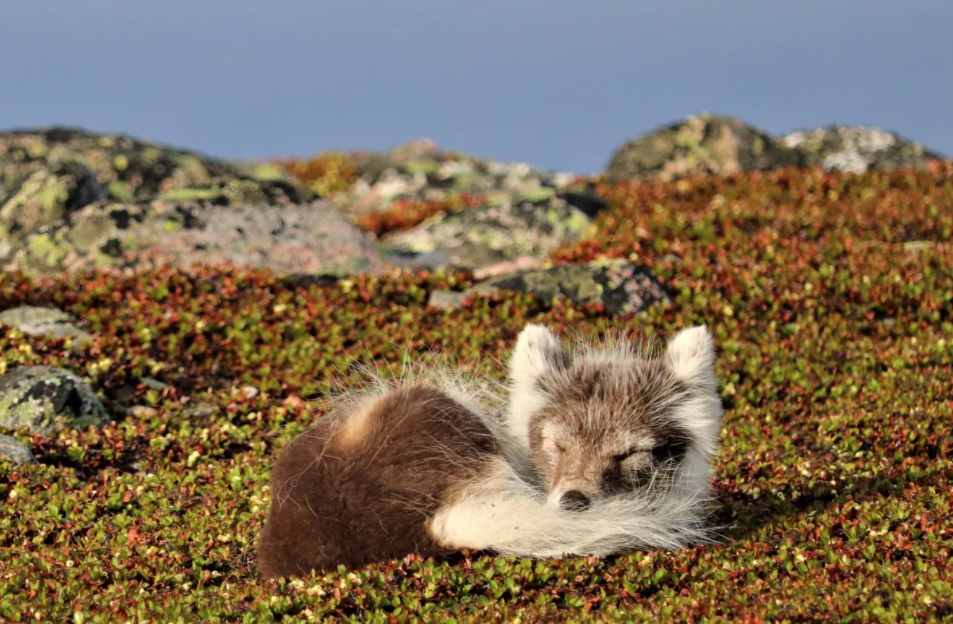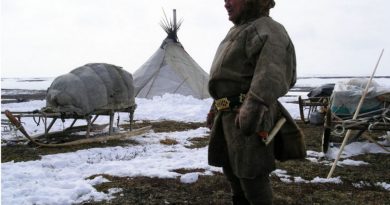As rabies returns to Arctic Canada, researchers look to predict future outbreaks

Susan Tulugarjuk was walking to work in Igloolik one morning in December when she felt something bite the back of the leg.
“I looked back, and there was a fox,” she recalled. “It attacked me from the back. I didn’t see it.”
The bite itself wasn’t too bad, but the bigger concern was rabies.
It’s been a banner year for rabies in Canada’s Arctic, with infected foxes showing up in several communities. Dogs have been attacked and sometimes killed.
Health officials have been issuing regular warnings to communities. Last week, people in Tuktoyaktuk, N.W.T., were cautioned about two dogs that showed signs of rabies.
Tulugarjuk got her shots. The disease can be fatal if left untreated. Today, she’s recovered but the whole thing has left her a little spooked.
“I started bringing a stick with me everytime I go out… just in case, you know,” she says.
“I started getting scared of dogs. I’m usually not scared of them.”
Always present in Arctic fox populations
Rabies are not new in the Arctic — documented cases go back decades.
But many researchers are now working to predict the periodic peaks in infection, like this winter’s outbreak in Nunavut.
“It’s something that’s enzootic — so it’s always present in Arctic fox populations,” said Brian Stevens, a wildlife pathologist for the Canadian Wildlife Health Cooperative. He’s based in Ontario and the Nunavut government referred questions to him instead of a local biologist.
“We see these cycles of outbreaks where there seems to be a higher prevalence of the virus in the population,” Stevens said.
Typically, local outbreaks happen on a 10- to 15-year cycle, Stevens said, with some outbreaks more severe than others.
“This is nothing new,” said Ben Kovic, who was a Nunavut conservation officer for more than 20 years and also served as chair of the Nunavut Wildlife Management Board.
Kovic grew up in Coral Harbour on Southhampton Island where most of his family and the other families he knew were fox trappers. There wasn’t much else to trap around there, he says.
“There was no wolverine, there was no wolf, there were no beaver and no nothing except for fox,” he said.

Even though rabies would pop up every so often, it wasn’t a big deal, Kovic said. People knew how to recognize it and avoid infected animals. It was rare for a person to get infected, he says.
“The only thing that we heard of, [was the] occasional dog, husky, you know, will get rabies,” he said.
Kovic, who lives in Iqaluit, is not sure whether this year’s rabies outbreak is more severe than most. He wonders if people in Nunavut’s capital city are just a little more sensitized to it.
“Everybody’s … concentrating on [fox] sightings, worried about this, worried about that. It gets to be quite the only thing happening,” he said.
Climate change and rabies
Still, Stevens and other wildlife researchers suggest there may be a general boom in Canada’s Arctic fox population this winter and therefore more rabid foxes. Fox numbers cycle up and down through the years, and according to Kovic, a boom year for a prey species like lemmings or voles is usually followed by a spike in the fox population.
But there could also be another factor that’s not as well understood, and that makes predictive models a little more complicated.
“Climate change is really going to affect the Arctic fox rabies dynamics,” said Dr. Emily Jenkins, a professor of veterinary microbiology at the University of Saskatchewan. She’s been studying Arctic foxes at Karrak Lake near Cambridge Bay, Nunavut, for years.
Foxes tend to roam across the polar region, and that’s how rabies gets around. Infection is fatal in most animals though there’s now evidence that some Arctic foxes survive an infection.
A lull period for rabies in one part of the Arctic might end when an infected fox wanders over the sea ice from somewhere else, sparking a new local outbreak.
But as sea ice diminishes in the Arctic, foxes may not be able to roam as freely or as far, according to Jenkins. Different populations might become more isolated.
“I guess it’s kind of good news, if there’s less sea ice and less connectivity of Arctic fox populations. We may very well see less rabies overall because it won’t be able to spread around the world every couple of years and flare up, if the fox populations are more isolated,” Jenkins said.

She says the flipside is that diminished sea ice means Arctic foxes are more landlocked, and so more likely to wander near people and dogs.
“This could be another factor that’s happening this year, is that if Arctic fox populations are not out on sea ice and they’re coming closer into communities … we may see more rabies, if it does get into a population.”
There’s also another wild-card factor that makes predictions about Arctic rabies difficult — the red fox. That species has been making its way further north into traditional Arctic fox territory and the implications are not yet clear.
Jenkins says it’s probably not good for Arctic foxes.
“Wild canids don’t tend to tolerate each other very well and they will compete for the same prey and they will actively kill each other.”
Red fox would “probably be a good host” for rabies in the North, she says, though they’re less likely to wander across the sea ice and spread infection to other regions.
Early warnings
Jenkins believes it would be valuable to be able to predict rabies outbreaks in the North, so that people and communities have an “early warning.” That way they can ensure that dogs are vaccinated, and that children know how to recognize infected animals and be cautious.
She also points out that in Europe, some wild red foxes are orally vaccinated against rabies, using bait. That’s something that might be considered around Northern communities, she says, to create a “buffer” of vaccinated foxes when rabies is widespread.

Researchers are now developing predictive models for outbreaks, she said.
But the ongoing COVID-19 pandemic has thrown a wrench in a lot of wildlife research. Jenkins would typically spend summers in Nunavut collecting data at Karrak Lake to track animals’ exposure to diseases over time. She’s been unable to go North for the last two years, and the upcoming field work season is also in question, she says.
“It means that we really lose some of our ability to track changes over time, which is, of course, one of the bigger questions about the Arctic, especially the western Canadian Arctic, which is undergoing climate change at about three times the rate of the global rate,” Jenkins said.
“When you’re looking at changes over time and you miss a few years, that’s a big data gap, unfortunately.”
Related stories from around the North:
Canada: One week after rabies warning, fox attacks person in Arctic Canada, CBC News
Greenland: In the Arctic, ‘everything is changing,’ massive animal tracking study finds, CBC News
Norway: Arctic fox’s rapid journey from Svalbard to Northern Canada stuns researchers, The Independent Barents Observer
Sweden: Swedish scientists ‘cautiously optimistic’ about Arctic fox population, Radio Sweden
United States: Arctic Cold Case: Thousands of mysterious animal deaths finally solved, Eye on the Arctic



